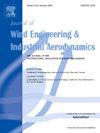基于贝叶斯优化技术的桥面横向流量控制
IF 4.2
2区 工程技术
Q1 ENGINEERING, CIVIL
Journal of Wind Engineering and Industrial Aerodynamics
Pub Date : 2025-02-01
DOI:10.1016/j.jweia.2024.105955
引用次数: 0
摘要
本文提出了一种新的桥梁风工程框架,将贝叶斯优化(BO)与计算流体力学(CFD)相结合,对大带桥面跨向控制参数进行优化。本研究利用BO框架对桥面前后边缘的吹吸正弦展向摄动(SSP)参数进行自动、数据驱动的调整。其主要目的是精细调整SSP控制,刺激尾流场中展向涡的二次不稳定性。这一过程有效地产生了顺流涡,抑制了展向涡,显著减轻了脉动气动力和涡激振动,提高了桥面气动稳定性。结果表明,BO框架驱动的SSP控制方法可以有效地减小气动力,同时找到最优的SSP波长。此外,通过对SSP控制中的多参数变量进行优化,实现了SSP的幅值和波长的最优组合。此外,还发现桥面后缘的抽气效果比前缘的抽气效果更好。本文章由计算机程序翻译,如有差异,请以英文原文为准。
Spanwise flow control of bridge deck using Bayesian optimization technique
This study introduces a novel framework in bridge wind engineering, merging Bayesian optimization (BO) with computational fluid dynamics (CFD) to optimize spanwise control parameters for the Great Belt bridge deck. This study leverages the BO framework for an automated, data-driven adjustment of the blow-suction sinusoidal spanwise perturbation (SSP) parameters at the leading and trailing edges of bridge decks. The primary aim is to finely tune the SSP control, stimulating the secondary instability in the spanwise vortices in the wake flow field. This process effectively generates streamwise vortices to suppress the spanwise ones, significantly mitigating fluctuating aerodynamic forces and vortex-induced vibration of the bridge deck, improving its aerodynamic stability. The results demonstrate that the BO framework-driven SSP control method can efficiently reduce the aerodynamic forces while finding the optimal SSP wavelength. Furthermore, through the optimization of multi-parameter variables in SSP control, the optimal combination of amplitudes and wavelengths for the SSP are achieved. Additionally, it was found that blow-suction at the trailing edge of the bridge deck is more effective than at the leading edge.
求助全文
通过发布文献求助,成功后即可免费获取论文全文。
去求助
来源期刊
CiteScore
8.90
自引率
22.90%
发文量
306
审稿时长
4.4 months
期刊介绍:
The objective of the journal is to provide a means for the publication and interchange of information, on an international basis, on all those aspects of wind engineering that are included in the activities of the International Association for Wind Engineering http://www.iawe.org/. These are: social and economic impact of wind effects; wind characteristics and structure, local wind environments, wind loads and structural response, diffusion, pollutant dispersion and matter transport, wind effects on building heat loss and ventilation, wind effects on transport systems, aerodynamic aspects of wind energy generation, and codification of wind effects.
Papers on these subjects describing full-scale measurements, wind-tunnel simulation studies, computational or theoretical methods are published, as well as papers dealing with the development of techniques and apparatus for wind engineering experiments.

 求助内容:
求助内容: 应助结果提醒方式:
应助结果提醒方式:


